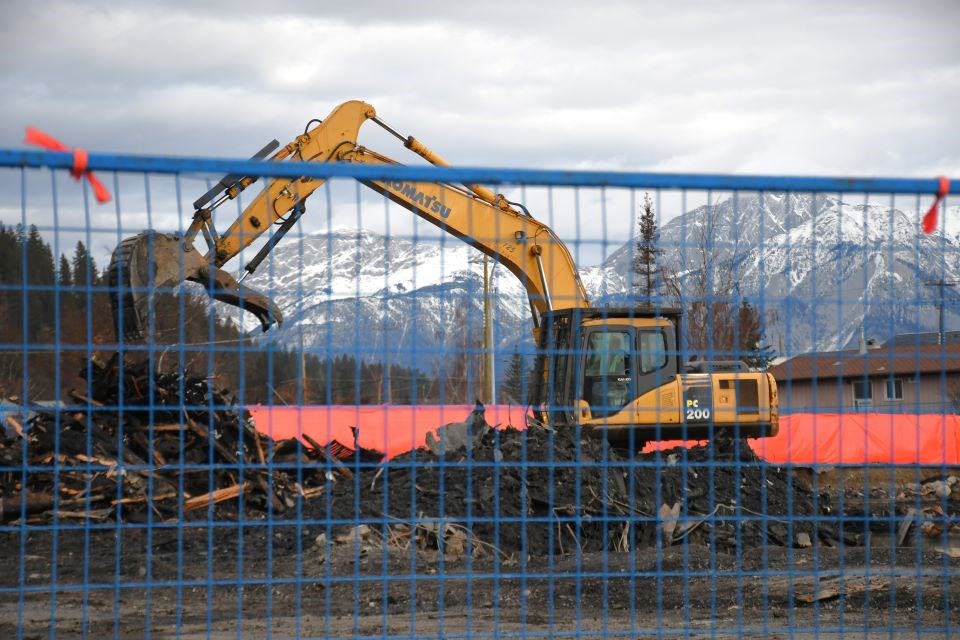The Municipality of Jasper is preparing to require leaseholders to assign a prime contractor for debris removal and demolition or take control of their own worksite.
A deadline has not been set and is pending.
“The primary intent is to ensure that the leaseholder is properly assigned as prime contractor and either directly themselves or through their chosen contractor,” said Michael Fark, director of recovery, told council on Tuesday (Nov. 19).
Fark noted this is to limit the municipality’s exposure to liability, as it is currently the prime contractor, and help incentivize property owners to decide to ensure all sites are appropriately cleaned up.
“This council, I imagine, can appreciate we cannot have sites un-demolished or unclean for an extended period of time,” he said.
EllisDon is leading the mass debris removal, but property owners have the option of selecting their own contractor. The cleanup is expected to wrap up in the spring.
Coun. Scott Wilson acknowledged the activity that had happened in the community over the previous week.
“It’s inspiring throughout the community,” he said. “Everybody’s feeling like we are moving forward now., so it’s great to see some fairly large-scale [work] we have going on in the residential areas.”
A debris removal map is available online to allow residents in damaged areas to anticipate when work near them may begin.
Contractors will be required to follow specific guidelines for managing dust and airborne particulates. The municipality says contractors may spray water mist while handling debris.
Anyone who witnesses incidents where dust suppression measures seem insufficient can report them to [email protected].
Site preparation is ongoing for interim housing at land parcels provided by Parks Canada within the townsite.
The Alberta government is providing $112 million for 250 modular homes, with the first of these expected to come online as early as January.
The request for proposals for low-to-medium-density modular housing closed Nov. 12, and the province is expected to announce who will be awarded the contract in the coming days.
Rebuilding guidelines
While the municipality is expected to take over land-use planning sometime next year, Parks Canada will continue to handle development applications for the townsite until then.
Parks Canada planner Emily Goldney said in an interview they had mostly been receiving questions of clarification since releasing the guide. Among others, these include what are the setbacks and height restrictions and how requirements would apply to specific sites.
“We’ve been receiving a lot of questions, understandably, because most people are not project managers, this is not their area of expertise,” Goldney said. “A lot of people are just seeking to understand what their options are.”
The agency recently made changes to its land use policy and released a rebuilding guide for property owners and developers.
Among other updates, developers will need to use non-combustible materials on the exterior of new buildings. This means no new wood roofing or siding.
Goldney explained the architectural motif ensured buildings would appear to be part of the natural surroundings by encouraging natural colours, natural materials and steeply pitched roofs.
“But we also recognize that policies and standards need to adapt and change with the time,” she said. “As environments change and our collective knowledge changes, and following the wildfire this summer, we knew we needed to update the standards to improve the fire resilience of our community.”
In addition, each home will be required to have a 1.5-metre buffer zone of non-combustible materials, and new coniferous trees must be planted at least 10 metres away from a building.
“Often when there is a wildfire, the big risk is the wind picking up embers and launching these embers ahead of the approaching fire, and having these embers start small fires that catch, and then if the house catches, that can cause the house next to it to catch,” Goldney said. “So, these fire resilience requirements are really intended to reduce the risk of embers catching and causing fires that can then spread through the community.”
Other updates will allow for more housing options. Leaseholders with lots formerly zoned for single-detached dwellings can now build one or two primary dwelling units on a lot, and there is a reduced parking requirement with only one stall required per primary dwelling unit.
There are also more options for accessory dwelling units. Leaseholders can build garden suites on residential lots, subdivision is now permitted in areas where it used to be prohibited and minimum lot widths have been eliminated.
“Housing has been a big problem in Jasper for a long time,” Goldney said. “A residential vacancy rate has been zero or near zero for a long time, and consultations over the last few years have consistently reiterated that the community needs more housing.”
She noted the rebuilding guide was primarily directed at residential buildings, and Parks Canada was working on getting more information on its website about the industrial area and outlying commercial areas.
Although most rebuilding likely won’t begin until next spring, Goldney is expecting a steady stream of applications. She added she and the other planning and development officers work and live in Jasper.
“It’s our friends and our neighbours and our colleagues who lost their homes and businesses and lost work as a result of this fire,” she said. “So, I just wanted to emphasize that we care, and myself and my colleagues and my municipal colleagues, we recognize the importance of making rebuilding as easy as possible, and we’re really here to help.”
Anyone with development inquiries or questions about the rebuilding guide can contact Park Canada’s development office at 780-852-6123 or [email protected]
Residents with rebuilding questions can attend drop-in sessions at the Parks Canada Administration Building on Mondays, Wednesdays, and Fridays from 1:30 to 3:30 p.m. and Tuesdays and Thursdays from 10 a.m. to 12 p.m.




